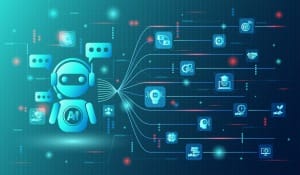Graph Technologies - Why is Graph Technology a Critical Enabler For Future Innovation?
- ATMECS – Content Team
Graph Technologies are one of the trending technologies nowadays to help analyze vast amounts of information. To understand why this is so, it may be useful to first understand what a graph is? A graph (or more commonly known as a network diagram) is simply a set of objects called nodes with interconnections called edges. And, why would one want/care to study graphs? Because they are everywhere. From a company’s internal email/chat data to complicated stock market trends, from social networks to information networks or even biological networks, graphs are ubiquitous. This is why gaining expertise in graph technology can set your company apart from competition.
What Is Metaverse?
Metaverse is not a single technology, solution, or platform. Instead, participating in the metaverse is all about using web 3.0 technologies to create an immersive experience for the audience. For businesses, investing in the metaverse is implementing newer internet technologies such as Extended Reality (XR), Virtual reality (VR), Mixed Reality (MR), Internet of Things (IoT), Augmented Reality (AR), and mirror worlds with digital twins to provide an interactive environment for the end user similar to the real-life interactions.
It is a technology concept of mixing the physical and virtual worlds of the customers. The crux of the technology is to improve engagement through immersion. Currently, the video game industry is growing leaps and bounds with VR headsets and unimaginably realistic graphics. The introduction of Non-Fungible Tokens (NFTs) has also increased the popularity of the metaverse, where users can create, buy and sell NFTs. These portable digital assets continue to gain value and momentum, especially in the blockchain world. Users can use cryptocurrency to invest in NFTs.
All evolving and established companies nowadays pay high salaries for graph analytics practitioners to help with their businesses and their clients. Graph technologies have different business aspects/challenges considered each time, making them a much sought field of expertise. Discerning relationships and interconnections we thought never existed now can be studied using graph technologies. Covid-19 proved that graph technologies to understand contact tracing were going to be very important to the future of technology. Digital marketers are breaking ground into behavioural analytics by studying the types of websites one visits in a given day through graphs. It is probably safe to surmise graph technology, while still in its nascent stages, can be guaranteed to be one of the top analysing techniques in the upcoming decades.
Graph Technologies and all you need to know about them.
Graph Technology is one of the most up-and-coming analytical technologies. It is often noticed that traditional graph analytics are not able to comprehend or discern patterns as the complexity and scale of today’s networks grows rapidly. Hence, the emergence of advanced graph technologies. Graphs aid in the visualization of data and maximize the understanding of the network relationships concepts. Since networks are easy to visually comprehend, the empirical observations of relationships or interconnections becomes straight forward.
Graph Technology helps organizations with a new and effective way of processing, managing, and storing enormous amounts of data. It is an innovative approach leading to timely insights helping grow businesses. For ex: Think of studying a network of people you get emails from and ones to respond to in a given day. Extrapolating the idea across the organization, can help HR discern who the power centers are or who the next (hidden) leaders are in an organization. Imagine doing a similar study if you work in the travel desk of the organization. Understanding patterns in business travel with graph technology can save an organization millions of dollars every year. For deeper understanding, graph technologies can be divided into three sections. They are – graph theory, graph analytics, and graph databases.
Graph Theory
Herein the graphs are drawn up and used to connect different paths and links of the objects and their interlinked relationships. Almost everything can be studied through graph patterns and understood instantly. Graph theory is a prominent part of the process as it lays the foundation for the whole procedure to be carried out further.
Graph Analytics
Issues arising in different subjects can be resolved by observing the general trends of the graphs and predicting the upcoming course of the concerned area. One of the most common uses of such graph technologies can be seen in the stock market. If you are into speculation trading, understanding false positives and for that matter, even false negatives, can make you quite lucrative if you are an expert in graph analytics.
Graph Databases
Graph databases allow people to store the results produced after the process of graph analytics is completed. Previously held data can be compiled in the same database to be easily accessible afterward. Data collection is one of the most prevalent examples of graph databases. Few leading graph analytics tools and databases include but are not limited to: Amazon Neptune, IBM Graph, Neo4J (this author recommends), Oracle spatial and graph, DGraph, Data Stax, Cambridge Semantics Anzograph etc.
Why will developers and analytics practitioners prefer Graph Technologies?
Graph technologies have started growing in the past couple of years, but the real question is – Are graph technologies worth the hype?
- Traditional analytics are based on concepts with long codes and hours of programs whose results are promising and accurate but time-consuming.
- It has been observed that while a specific amount of data can take up to 1000-4000 lines of code, it can be overcomed easily by completing the task in less than 400 code lines in Graph analytics.
- Ease of learning, ease of understanding and use, ability to scale, ability to handle complexity are all compelling reasons why graph technologies have now become very attractive. As cloud computing matures, we will see more practitioners wanting to innovate in the graph technology space.
- Graph technologies have use cases across industry domains as networks exist virtually everywhere. Gaining expertise in graphing technologies will ensure an exciting career path.
Graph technologies are expected to be extremely promising in the upcoming decade. They are considered one of the significant strides needed for advancement in technology. Different sectors, like health, business, banking, agriculture, logistics, utilities etc., are looking for its applications in their respective fields.



